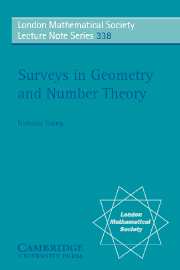Book contents
- Frontmatter
- Contents
- Preface
- Affine embeddings of homogeneous spaces
- Formal groups over local fields: a constructive approach
- Classification problems and mirror duality
- Birational models of del Pezzo fibrations
- Best Diophantine approximations
- Projectively dual varieties of homogeneous spaces
- Equivariant embeddings of homogeneous spaces
- Geometric quantization and algebraic Lagrangian geometry
Formal groups over local fields: a constructive approach
Published online by Cambridge University Press: 07 May 2010
- Frontmatter
- Contents
- Preface
- Affine embeddings of homogeneous spaces
- Formal groups over local fields: a constructive approach
- Classification problems and mirror duality
- Birational models of del Pezzo fibrations
- Best Diophantine approximations
- Projectively dual varieties of homogeneous spaces
- Equivariant embeddings of homogeneous spaces
- Geometric quantization and algebraic Lagrangian geometry
Summary
Introduction
This paper is dedicated to the work of St. Petersburg mathematicians on formal groups over local fields. This work can be divided into three main topics.
The first consists of explicit reciprocity formulas on formal groups over local fields. This activity in St. Petersburg was started by S. Vostokov in the 1970s and was carried on by his students.
The second topic is the explicit classification of formal groups over local fields. It was started recently by M. Bondarko and S. Vostokov. One should also mention an earlier work of O. Demchenko. We also describe briefly some recent results on the classification of finite local commutative group schemes over complete discrete valuations fields (obtained by Bondarko).
We note that recently both groups of results were carried over to complete discrete valuation fields with imperfect residue field; see and.
The third topic is the connection between formal groups and Galois module structure. This subject was studied by M. Bondarko.
One of the main features of this work is that the results do not require any sophisticated knowledge. An interested reader may find the proofs in the literature which we cite and see that the proofs are relatively simple (though a little technical sometimes).
In Section 1 we give the most basic definitions: a formal group, its logarithm, a homomorphism between two formal groups and the notion of formal module. We also give the definition of Lubin-Tate formal groups, which are very important in local algebraic number theory.
We begin Section 2 by recalling the notion of a p-typical formal group.
Information
- Type
- Chapter
- Information
- Surveys in Geometry and Number TheoryReports on Contemporary Russian Mathematics, pp. 52 - 87Publisher: Cambridge University PressPrint publication year: 2007
